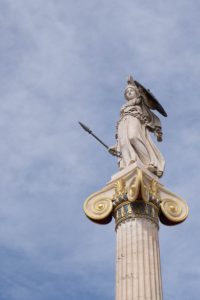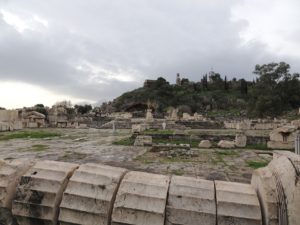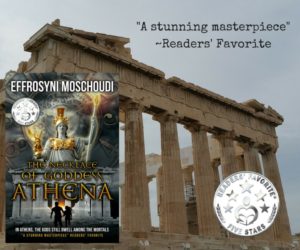Today, I am re-issuing an old post of mine. It is about Goddess Athena and her magnificent temple on the Athens Acropolis – the Parthenon. I hope you’ll enjoy it!

Goddess Athena was greatly revered by the ancient Greeks. One of her many epithets, Pallada (or Pallas), was owed to the peculiarity of her birth. According to legend, she sprang forth from the forehead of her father Zeus, fully armed and shaking her spear fiercely, making a fearsome sound. The word Pallada is derived from the Greek word ‘pallein’ which means ‘to shake’.
This divine young virgin was among other things, the goddess of wisdom and justice. Her sacred symbols include the owl and the olive tree. According to legend, she challenged Poseidon on the Athens Acropolis aiming to win the patronship of the city. The two Gods agreed to each offer a gift before king Cecrops and the witnessing Athenians; the better gift would grant the deity the greatly desired patronship status.

Poseidon went first, striking the Acropolis Rock with his trident to produce the Sea of Erechtheus; a salt spring. As the myth goes, the Athenians weren’t particularly impressed with this gift, as the water wasn’t fit to drink. Poseidon then offered a second gift, a horse, to be used for war. When Athena’s turn came, she struck the ground with her spear and an olive tree sprouted from it swiftly; a magnificent gift to be used for nourishment, beauty and light in the dark. King Cecrops and the people of Athens favored the gift of the olive tree and declared Athena the patron deity of the city that inevitably took on her name.
According to myth, Poseidon was enraged by this and stormed to western Attica, where he flooded the Thriasian Plain. His rivalry with Athena, even though she is his niece, is legendary in Greek mythology. Homer’s Odyssey illustrates it heavily, telling the world of this fearsome uncle and his cunning niece who fight over the fate of Odysseus. The cunning Greek king and his loyal crew roamed the sea for years, going through infamous trials and tribulations as they made their way back home to Ithaca after the Trojan War. Although Poseidon tried to lead Odysseus to his demise, furious with him for blinding his beloved son, the Cyclops Polyphemus, Athena kept going against his will assisting Odysseus out of difficult situations, until he made it safely home back to his palace and faithful wife, Penelope.

The Athenians loved their patron Goddess like no other deity. During the Golden Age of Athens (460-430 BC), under the leadership of Pericles, they built the Parthenon atop the Acropolis hill, along with other glorious edifices; all of them famous through history in their own right as well: The Propylaea, The Erechtheion and The Temple of Athena Nike.
Famous architects Iktinos and Kallikrates took over the construction and the legendary sculptor Phidias was commissioned to create the colossal chryselephantine (gold and ivory) statue of Athena for the interior of the Parthenon, which was named Athena Parthenos (Athena The Virgin). Phidias also sculpted the gigantic bronze statue Athena Promachos (Athena standing in the front line in battle). This statue was placed between The Parthenon and The Propylaea.
The word Parthenon is derived from the word ‘parthenos’ which means ‘virgin’ as per the epithet ‘Virgin’ for Athena. Once in four years, the Panathinaia Festival took place in honor of the Goddess. Although it also involved athletic events similar to the Olympic Games, the main event was the religious procession that made its way from The Parthenon to the town of Elefsis via Iera Odos (The Sacred Way); today, Iera Odos survives as a busy motorway between Athens and the historical town of Elefsis (also spelled Eleusis in English). This historic town is also the very site of the infamous Eleusinian Mysteries of antiquity that to this day, historians know very little about.

The archeological site in Eleusis, the seaside town west of Athens that held the infamous Eleusinian Mysteries in ancient times.
Over the millennia, The Parthenon, one of the seven wonders of the ancient world, has suffered devastation repeatedly and on a large scale. Other than being occupied by the Turks and turned into a mosque in the 1460s, it was also bombed by the Venetians in 1687, cruelly looted by Lord Elgin in 1806 and has even suffered substantial damage by overzealous Christian priests who destroyed the depictions on the friezes that seemed indecent in their eyes.
In order to graphically illustrate the Parthenon back in its glory days as well as its demise through the millennia, I’m including below a remarkable video by the Greek Ministry of Culture. I hope you’ll also enjoy therein, a classic poem by the legendary philhellene, Lord Byron. The great romantic poet’s imagination has captured the wrath of Athena (Minerva, in Roman) further to the merciless destruction of her sacred temple. For the benefit of poetry lovers, I’m including here a link to the whole poem, that was written in Athens in 1811 by the great British poet.
Note: This post was originally published on the fabulous blog of author and historian, Adam Haviaras. If you love Greek history, Greek travel articles, and historical fiction set in ancient Greece then you should really check out this author. Visit Adam’s blog here

Do you love Greek myths? My highly acclaimed fantasy, The Necklace of Goddess Athena, combines delightful Greek myths with compelling family drama. Check out the book trailer and download a FREE excerpt here
TWEET TO SPREAD THE WORD:
Goddess Athena and her temple, The Parthenon #myths #classics #folktales Click To TweetPlanning to visit Greece? Check out our insider’s guide to Corfu! For delicious Greek recipes, go here. Are you an author? Check out our FREE promo tips & resources here.

